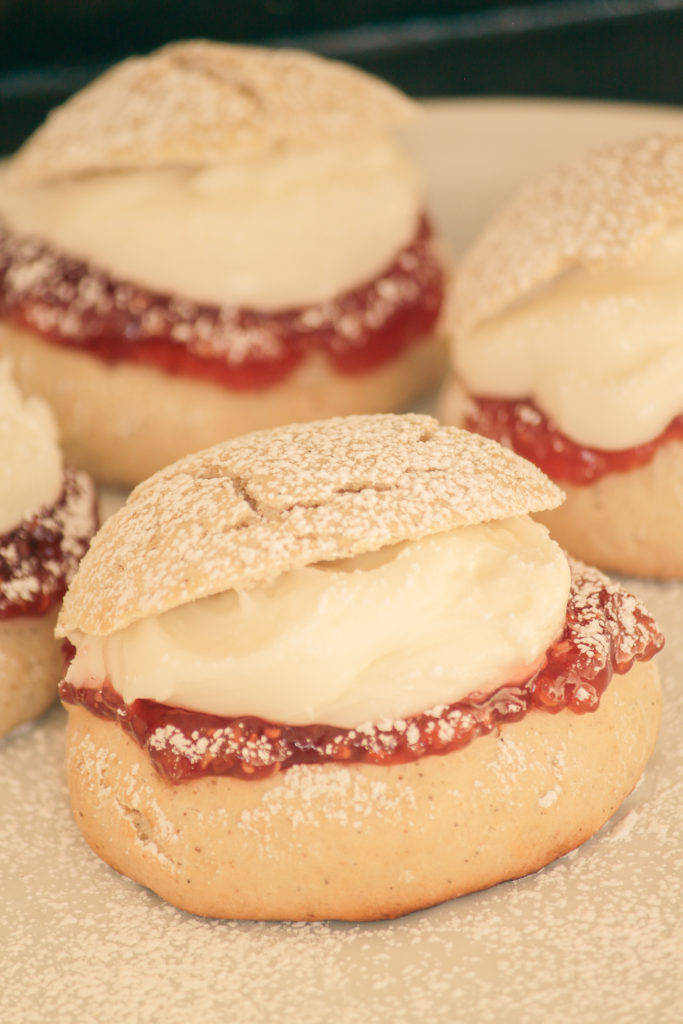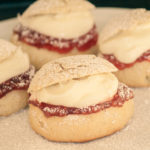
History
There is perhaps no other season throughout the entirety of the Church year that so greatly focuses on food as Gesimatide. During the celebration of Carnival or Mardi Gras, Christians take seriously the task of “eating, drinking, and being merry,” while attempting to empty their household stores of dairy, eggs, fats, sugars, and meats to get ready for the impending Lenten time.
Since Septuagesima marks the beginning of this Carnival period of feasting, it should be no surprise that with the “gesima” Sundays come a variety of culinary traditions. Many cultures all over the world have developed their own unique celebratory foods and recipes to help them usher in the Carnival season and prepare themselves for Lent.
In Scandinavia, which is historically Lutheran, Carnival is known as fastelavn. An extremely popular celebratory period, fastelavn features children dressing in costumes and gathering treats for parades. Other major public feasts and parties are held throughout Oslo in the pre-Lent weeks and include masked balls, themed opera performances, and Carnival concerts.
Many of these traditions can be traced back to their adoption in Norwegian culture in the early 1700s. At that point, inspiration for these celebrations came to Scandinavia from France, where Carnival had previously been celebrated for centuries.

Fastelavnsboller
One of the most popular Norwegian foods that is consumed during Carnival is fastelavnsboller. Found in various forms throughout Scandinavia, these “berry buns” are traditionally eaten throughout the Gesimatide season as a way to use up excess dairy and eggs before Lent.
They most closely resemble a pastry-like roll filled with jam and whipped cream, coated with sugar and frosting. The abundance of cream in the dessert has always been a feature of fastelavnsboller, although the popularity of using whipped cream to fill the buns would have only originated in the twentieth century or so. On the other hand, the inclusion of cardamom is a historic and characteristic part of this recipe, although we have also had success substituting cinnamon or nutmeg.
Ingredients
1 packet dried yeast
1 cup whole milk
3 tbsp butter, melted
½ cup sugar
2-3 cups all-purpose flour
½ tsp salt
1 tsp baking powder
2 tsp ground cardamom
1 egg, beaten
1 jar of raspberry jam
1 cup whipping cream
1 tbsp sugar
½ tsp vanilla extract
¼ cup powdered sugar
Instructions
- Take milk out of the fridge and let it set for a couple of hours until tepid. Add the dried yeast to the milk, cover, and let it activate for about 15 minutes until frothy.
- Pour the mixture into the bowl of a stand mixer and stir with a dough hook, adding in the melted butter. Add the sugar and stir again. Add half of the flour as well as the salt, baking powder and ground cardamom. Add half the beaten egg (reserve the other half for brushing before baking).
- Mix well and start adding in more of the flour, bit by bit, until the dough becomes slightly sticky. Knead the dough for at least 5 minutes. Cover the bowl and let rise until doubled – about 30–40 minutes.
- Turn the dough out to a floured surface and knead for a few minutes, adding more flour if needed. You want a firm but moist dough. Cut the dough into 12 equal-sized pieces and place on a baking sheet. Leave them rise again for 25–30 minutes.
- Preheat the oven to 200°C (400°F) Gas 6.
- Brush each bun with the other half of the beaten egg and bake for 8–10 minutes. Remove them from the oven and cover the buns with a slightly damp dish towel immediately – this will prevent them from forming a crust.
- When they have cooled completely, cut a ‘lid’ off the buns – 1 inch from the top. Add about 2 tsp jam on the bottom of the buns.
- Whip your cream with sugar and vanilla (if using) until stiff, then dollop cream on top of the jam. Put the ‘lids’ back on and dust them lightly with powdered sugar before serving.
Septuagesima Berry Buns
Ingredients
- 1 packet dried yeast
- 1 C whole milk
- 3 tbsp butter melted
- ½ C sugar
- 2-3 C all-purpose flour
- ½ tsp salt
- 1 tsp baking powder
- 2 tsp ground cardamom
- 1 egg beaten
- 1 jar of raspberry jam
- 1 C whipping cream
- 1 tbsp sugar
- ½ tsp vanallia extract
- ¼ C powdered sugar
Instructions
- Take milk out of the fridge and let it set for a couple of hours until tepid. Add the dried yeast to the milk, cover, and let it activate for about 15 minutes until frothy.
- Pour the mixture into the bowl of a stand mixer and stir with a dough hook, adding in the melted butter. Add the sugar and stir again. Add half of the flour as well as the salt, baking powder and ground cardamom. Add half the beaten egg (reserve the other half for brushing before baking).
- Mix well and start adding in more of the flour, bit by bit, until the dough becomes slightly sticky. Knead the dough for at least 5 minutes. Cover the bowl and let rise until doubled – about 30–40 minutes.
- Turn the dough out to a floured surface and knead for a few minutes, adding more flour if needed. You want a firm but moist dough. Cut the dough into 12 equal-sized pieces and place on a baking sheet. Leave them rise again for 25–30 minutes.
- Preheat the oven to 400°F.
- Brush each bun with the other half of the beaten egg and bake for 8–10 minutes. Remove them from the oven and cover the buns with a slightly damp dish towel immediately – this will prevent them from forming a crust.
- When they have cooled completely, cut a ‘lid’ off the buns – 1 inch from the top. Add about 2 tsp jam on the bottom of the buns.
- Whip your cream with sugar and vanilla (if using) until stiff, then dollop cream on top of the jam. Put the ‘lids’ back on and dust them lightly with powdered sugar before serving.



[…] the Scandinavian Lutheran tradition, it is customary for congregations to consume fastelavnsboller together after the Sunday service and then to go home and begin cooking and baking for the […]